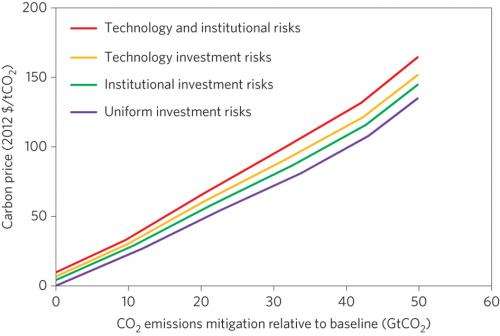Taking into account real-world factors that affect investment decision-making could substantially increase estimates of the cost of limiting global warming. It could also shift some of the burden of cutting emissions from developing to industrialized countries. These are the central findings of a paper published today in Nature Climate Change, authored by the Joint Global Change Research Institute (JGCRI), the University of Maryland School of Public Policy, Resources for the Future and the University of California at San Diego.
"In the past, researchers have overlooked the huge variation in real-world factors that affect where and how firms make investments in risky new technologies. For example, investment banks would charge higher interest on a loan to a firm that builds a wind farm in India compared with, for example, the same project in the U.S., because banks treat the Indian investment as a financially riskier bet. Our study looks at how the variation in investment risks impacts which technologies are actually used to reduce emissions and where those emissions reductions occur," said Gokul Iyer, a researcher at JGCRI, a collaboration between Pacific Northwest national laboratory and the University of Maryland and lead author on the study.
Previous studies that looked at the cost of reducing emissions assumed that firms all across the globe have similar access to investment capital for undertaking emissions reductions. They also made a wide range of other simplifying assumptions, such as the assumption that firms can trust governments to adopt policies that are credible over long time periods. These simplifying assumptions have been an essential first step in modeling how the global economy functions, how countries can reduce emissions and at what cost. But, as the Intergovernmental Panel on Climate Change (IPCC) concluded in its most recent assessment of the climate change issue, more realistic assumptions are needed to improve cost estimates.
This new paper explicitly explores two real-world factors, namely, variation in investment risks across regions of the world and across technologies. It finds that accounting for risk increases the cost of halving CO2 emissions in 2050 by up to 40%. Halving CO2 emissions by 2050 is broadly in line with the emissions goals being considered by scientists, negotiators and politicians who are working toward a new international agreement on climate change. The deadline for their efforts is a large meeting late this year in Paris.
An even more striking finding of the study is that emissions reductions would shift from emerging countries, such as India and South Africa, toward the advanced industrialized countries. It is widely assumed that reducing emissions would be cheaper in the emerging countries because they are at an earlier stage of building their energy systems and their technologies are relatively less advanced. This new study finds that the higher risk of investing in those countries results in firms that worry about risk and cost to focus on markets where they know how to do business more reliably. "This study has changed my understanding of emissions mitigation and shows the importance of getting the details right," said Jae Edmonds, Public Policy professor at the University of Maryland and chief scientist at the Pacific Northwest National Laboratory and one of the study authors.
The analysis modified the Global Change Assessment Model (GCAM), one of the most widely used models for studying the cost of reducing emissions and developed by a team of scientists at JGCRI.Using GCAM, the researchers explored scenarios in which firms face investment risks that vary across countries depending on the quality of institutions. To do so, they used an index based on a survey of investment risk compiled by the World Economic Forum (WEF).The WEF survey offered a special insight into this phenomenon of risk because it reflects the assessments of some of the world's most knowledgeable business elite. WEF, among other things, hosts the annual business and government summit in Davos, Switzerland. In the paper, the research team also varied risks by technology—allowing the model to reflect the reality that mature technologies such as gas turbines and conventional coal power are proven and not particularly risky whereas other technologies, such as advanced nuclear power plants and plants that capture and store pollution underground, are riskier bets.
This paper explores only some of the long list of factors that affect real-world emissions and costs of emission controls. It is conceivable that other factors might have different or even counteracting effects. For this reason, the paper also calls for further research that incorporates real-world assumptions into these computer models so as to better understand the real costs and benefits of reducing emissions.
More information: "Improved representation of investment decisions in assessments of CO2 mitigation." Nature Climate Change (2015). DOI: 10.1038/nclimate2553
Journal information: Nature Climate Change
Provided by University of Maryland























